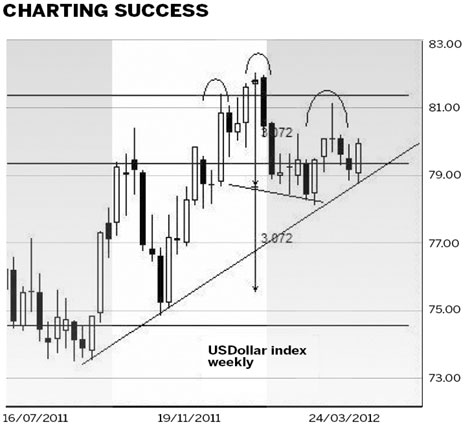Capital flows are boosting US bourses
Updated: 2012-04-09 08:06
By Daryl Guppy (China Daily)
|
||||||||

The United States market is surging as money flows from bonds into equities. Persistent statements from the Federal Reserve Chairman Ben Bernanke that he intends to keep interest rates low for some considerable time guarantee a flow of cheap money. In the first round of quantitative easing, this cheap money flowed quickly out of the US markets and into commodities and foreign markets. The second round of quantitative easing saw cheap money flow into bonds and added another surge to commodity prices.
Bernanke is not suggesting a third round of quantitative easing, so there is no longer the expectation of a large flow of newly created money into the market. Instead, by signalling a prolonged period of low interest rates, the fed chairman is encouraging greater appetite for risk among investors. This is not just institutional investors and fund managers. There is increasing evidence of more money from retail traders flowing into the US market.
The current rise in the Dow Jones started with institutional money, but retail traders have joined in and helped push the index above the critical long-term uptrend line. Now this trend line is acting as a support level rather than a resistance level. This clears the Dow to rise toward 14200.

The US market is moving into the season for earnings reports, and it is widely expected that earnings will be flat. Retail investors think this is not a bad thing because, they reason, flat earnings can only improve. An improvement in earnings increases the value of dividends and puts the income-investment story back on track. Suddenly bonds and cash no longer look attractive. By keeping money cheap, and guaranteeing it will continue to be cheap, Bernanke has finally enticed the retail investors back into the pool of market risk.
This is also encouraged by the increase in inflation to around 2.7 percent, created by a previous surge in commodity prices, and in oil prices in particular. The gradual increase in inflation is enough to outweigh any increase in wages, which have been under downwards pressure for several years. If you want to get ahead of inflation, then it is wealth gains that will deliver. These gains come from asset prices that are further increased as a result of inflation.
One of the factors that will push inflation higher is any weakness in the US dollar. The US dollar index is a basket of currencies. They are the euro, the yen, the British pound sterling, the Canadian dollar, the Swiss franc and Swedish krona. The dollar index is used to measure the the strength or weakness of the US dollar.
There are important features in the dollar index chart. The pattern is the uptrend line that has been in place since September and was tested in November and again in March. The retreat in the dollar index is testing the trend line again. A fall below the line has a downside support target near 75 US cents.
A fall below the value of the trend line will confirm the bearish signal from the so-called head and shoulder pattern. This will indicate more weakness in the US dollar and will help to push US inflation higher. In an inflationary environment, the market often also rises, so investors are looking for a continuation of the uptrend in the Dow. This is also bullish for commodity and gold prices.
The author is a well-known international financial technical analysis expert.

 Relief reaches isolated village
Relief reaches isolated village
 Rainfall poses new threats to quake-hit region
Rainfall poses new threats to quake-hit region
 Funerals begin for Boston bombing victims
Funerals begin for Boston bombing victims
 Quake takeaway from China's Air Force
Quake takeaway from China's Air Force
 Obama celebrates young inventors at science fair
Obama celebrates young inventors at science fair
 Earth Day marked around the world
Earth Day marked around the world
 Volunteer team helping students find sense of normalcy
Volunteer team helping students find sense of normalcy
 Ethnic groups quick to join rescue efforts
Ethnic groups quick to join rescue efforts
Most Viewed
Editor's Picks

|

|

|

|

|

|
Today's Top News
Health new priority for quake zone
Xi meets US top military officer
Japan's boats driven out of Diaoyu
China mulls online shopping legislation
Bird flu death toll rises to 22
Putin appoints new ambassador to China
Japanese ships blocked from Diaoyu Islands
Inspired by Guan, more Chinese pick up golf
US Weekly

|

|






